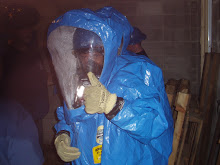Monday, March 14, 2011
CSB Videos
While preparing for a class scheduled in the next couple of weeks, I decided to look on the CSB's (Chemical Safety Board) website. They have videos featuring several different chemical accidents that reveiws what happened and how it could have been prevented. These videos are a mix of interviews with employees and experts, video footage and animation of what is believed to have happened. These videos can be a valuable tool to use for training both workers and rescue personell. You can access their website at http://www.csb.gov/
Thursday, March 10, 2011
SMART Objectives
Attended a NIMS ICS-300 class this week. This class discussed the incident command process for larger incidents and events. For the non-Fire service folks, this is basically a resource management process or system. One of the early process steps in dealing with an incident is to develop incident objectives. These objectives guide the mitigation priorities to ensure life safety, incident stabilization and property preservation. The incident objectives state what will be accomplished.
Incident objectives need to be Specific in describing the objective, Measurable, Action oriented, Realistic and Time sensitive. You can use the acronym SMART as a tool in remembering the characteristics for good objectives.
Incident objectives need to be Specific in describing the objective, Measurable, Action oriented, Realistic and Time sensitive. You can use the acronym SMART as a tool in remembering the characteristics for good objectives.
Monday, March 7, 2011
Preparing for Confined Spaces
Confined space fatalities are totally preventable. Over the last three years, the annual average fatality rate is over 100 deaths. If these deaths are preventable, then why are there still people dying in confined spaces? I believe that there are several key factors as to why. First, there is a "mentality" of the would be rescuer. Believing that one can save another persons life under any condition is naive. Professional rescuers train continuously on a wide range of equipment and potential scenarios. It is unlikely that a "layman" rescuer has the equipment, training or ability to conduct a rescue requiring vessel entry. It is hard to stand by and do nothing, but that is what it takes to save your own life. Your family and friends depend on it. Second, some facilities do not have proper policies or procedures to instruct the worker as to what are acceptable actions. Without guidance, a person will do what he or she believes is the best course of action. Finally, do the workers have the proper training on the procedures and equipment that they are being asked to use. Any loss of life or injury involving confined spaces is tragic; these incidents are totally preventable.
Thursday, March 3, 2011
Grain Handling Facilities
OSHA has sent letters to over 10,000 grain handling facilities last month, warning them of the hazards associated with workers entering storage bins. Over 50 people lost their lives in grain bin accidents in 2010 alone. Several of those were in Illinois. OSHA has a Fact Sheet that outlines some of the hazards and provides recommendations for mitigation. Grain storage bins are dangerous for workers to enter due to bridging and "running" characteristics of the grain. Confined space protocols and proper equipment can protect workers as they enter grain storage bins to perform their duties.
Subscribe to:
Posts (Atom)


